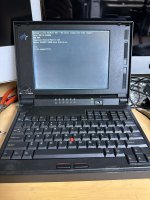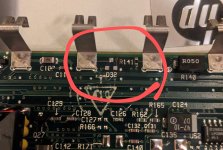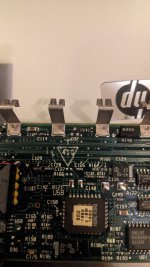The PS/Note 425 was the final gasp of IBM's pre-ThinkPad laptop series. It's a ThinkPad 350 with a different badge essentially. Let's see how good of a vintage laptop it makes.
As far as the design goes, it’s basically your standard looking 90s IBM laptop. That’s to say, it used that bento box form factor that all the others did. There’s nothing wrong with that of course, if anything, it’s what makes them iconic. The front of the laptop is bare, besides for the two display latches. The left side is also blank, no I/O in site. The back is where the bulk of the 425’s ports are located. The PS/2 keyboard/mouse port and the power jack are always visible, while the rest is hidden behind a port door. Unfortunately, the latch for the door is made out of brittle plastic, and now fails to hold the door in place. Behind the door is the expected Serial, Parallel and VGA out ports, but also a hard power switch. Laptops at this point in time usually didn’t have much in terms of soft power, you’d have to flip the switch in order to start the laptop. Unfortunately, the switch is quite stiff and doesn’t feel anything like the amazing power switches on IBM desktops. Finally, the right side of the laptop houses a built in modem, and a 3.5” floppy disk drive.
The bottom is equally uneventful. It’s got a door for the battery bay, which is empty. The battery is also extremely difficult to remove out of one of these too, and I ended up damaging the contacts trying to get it out! It’s an NiMH battery, so you’ll want to remove it in case it leaks. There’s one more door on the bottom, which allows you access to the RAM expansion slot, the modem daughterboard, and the CMOS and suspend batteries.
It's early enough that there isn't much in terms of a palm-rest for comfortable typing, but the keyboard is very good. The inside looks pretty standard. It does have appears to be a soft power button, but pressing it while the laptop is running will enter it into a primitive form of sleep mode. A NiCad backup battery will allow you to swap the main battery out for another one while the computer is in this suspend mode, saving you the time of opening all your documents back up.
the 425 was a consumer laptop, so it doesn’t have all the bells and whistles of the high end ThinkPad 700 series, however, it isn’t terribly slow either (and doesn't have that awful rubber finish thank god). It’s powered by a 25MHz Intel 486 SL processor. It has 4MB of RAM soldered onto the board, with that aforementioned expansion slot available to add more. It even looks like it may be a standard type, not something proprietary, though I’m not positive about this. The hard drive was a 128MB capacity. The LCD on these is really the biggest let-down, it’s a passive matrix grayscale panel, which isn’t too bad in it of itself, but this one ghosts really bad compared to others I’ve seen. And yes, I’ve recapped it. More on that later on. Like every other early 486 laptop, it has no built in sound card, PC speaker only. It supports VGA graphics though, so you can play games on it just fine, as long as you can tolerate the low quality screen and low quality sound. Planet X3 is totally playable though, as are any other period games that don’t move too fast.
As I’ve mentioned, the screen isn’t great. However, the keyboard definitely is. It’s a classic ThinkPad quality keyboard, manufactured by Lexmark. Key feel is excellent, and it’s definitely one of my favorites. The TrackPoint isn’t bad either. Performance running Windows 3.1 is perfectly acceptable, and as I said just a second ago, simpler DOS games without fast movement, like Planet X3, play great on one of these. Any shortcomings with the LCD also go away if you’re planning on using an external monitor as well of course.
Doesn't sound too bad so far, screen aside, but unfortunately these are a reliability nightmare.
First off, capacitors. It's got a handful of surface mount electrolytics on it, which will absolutely give you trouble, and did for me. There's one on the motherboard, one on the floppy drive, one on the backlight inverter board, and 8 on the LCD. I've replaced the motherboard and LCD caps, got to do the rest.
Next, display hinges. Unfortunately, the 425 has some of the worst. 90s laptops are plagued with hinge problems, due largely to poor design and plastic that has become very brittle with time. The hinge mounts in the PS/Note 425 will nearly always snap apart, and leave you with stress cracking on the housing, or a completely floppy hinge, as mine has done. This isn’t the end of the world if you just prop it up against something, but it vastly limits its portable potential. Fixing it is difficult too, just because of how bad the design is. You can go ahead and epoxy everything up, but it will probably end up cracking somewhere else, because the metal hinges themselves have grown very stiff with age, and are a generally poor design.
And finally, other failures. First off, IBM put a bunch of sound dampening foam inside the case, and it’s turning back to oil. A pain to clean up, but not the worst thankfully. The rubber feet on the bottom also melt most of the time. Another part that melts is the rubber trackpoint cap. The original is a really old school eraser-head style, even earlier than the cat’s tongue style. The problem is that it leaves residue on the trackpoint sensors and causes drift. Best replace it with a cat’s tongue style and clean the sensors best you can. The floppy drives seem reasonably reliable, I don’t think they’re belt driven as mine definitely wouldn’t work anymore if they were. I did have to lubricate the drive head shaft before my drive would read though, but that’s pretty common. The suspend button also jammed a few times for me, leading to freak power issues. It took me a good while before I figured out that the jammed button was all that was causing them.
Then there are battery leaks to account for. The main battery is NiMH, as mentioned earlier, so get that one out, it’s gonna be dead either way. The CMOS battery is a lithium coin cell, so that’s fine, but then there’s the suspend battery. It’s a 2-cell NiCad battery, and will definitely leak and damage anything around it. Luckily I managed to escape that with mine, although the suspend battery in a second parts unit I ordered had begun to leak.
And finally, a word of caution. The keyboard ribbon cables are super fragile. If you bend them too much, they’ll micro-fracture internally and quit working. It happened with my first unit and led me to having to buy a parts unit to get a keyboard from, which was actually branded as a ThinkPad 350 funny enough.
And that’s really all I can think of to say, as you can see, particularly problematic as compared to other laptops of the time. All of this is quite common, but epoxy will fix the hinge woes in many other systems. It may be possible here, but again, the design of them is particularly bad.
And so, a final rating. I’m going to have to give the PS/Note 425 a 3/10 on my laptop review scale. It does have its redeeming qualities, mainly the excellent keyboard. They’d make an excellent typing machine, but again, the hinges ruin chances of portability so I can’t recommend that use case either. It’s really in a tough spot, as the only thing I can recommend it for is if you’re like me, and you enjoy tinkering with and fixing weird, kind of crappy laptops. I for one love this thing, for all of the above issues. I get to say that I’m one of the only ones who’s bothered fixing one of these things, and hinge issues aside, mine works perfectly now, and I do use it quite a bit. But yeah, can’t give it anything higher than a 3. If you're looking for a good 486 laptop, look elsewhere to Toshiba, Compaq, or a number of others.

If this review read a bit like a script, it's because it was adapted from one. I'm working on a full review video on this laptop! But this section of the forum really needs some more content, so I figured I'd adapt it for here. Will be making more of these if people are interested.
As far as the design goes, it’s basically your standard looking 90s IBM laptop. That’s to say, it used that bento box form factor that all the others did. There’s nothing wrong with that of course, if anything, it’s what makes them iconic. The front of the laptop is bare, besides for the two display latches. The left side is also blank, no I/O in site. The back is where the bulk of the 425’s ports are located. The PS/2 keyboard/mouse port and the power jack are always visible, while the rest is hidden behind a port door. Unfortunately, the latch for the door is made out of brittle plastic, and now fails to hold the door in place. Behind the door is the expected Serial, Parallel and VGA out ports, but also a hard power switch. Laptops at this point in time usually didn’t have much in terms of soft power, you’d have to flip the switch in order to start the laptop. Unfortunately, the switch is quite stiff and doesn’t feel anything like the amazing power switches on IBM desktops. Finally, the right side of the laptop houses a built in modem, and a 3.5” floppy disk drive.
The bottom is equally uneventful. It’s got a door for the battery bay, which is empty. The battery is also extremely difficult to remove out of one of these too, and I ended up damaging the contacts trying to get it out! It’s an NiMH battery, so you’ll want to remove it in case it leaks. There’s one more door on the bottom, which allows you access to the RAM expansion slot, the modem daughterboard, and the CMOS and suspend batteries.
It's early enough that there isn't much in terms of a palm-rest for comfortable typing, but the keyboard is very good. The inside looks pretty standard. It does have appears to be a soft power button, but pressing it while the laptop is running will enter it into a primitive form of sleep mode. A NiCad backup battery will allow you to swap the main battery out for another one while the computer is in this suspend mode, saving you the time of opening all your documents back up.
the 425 was a consumer laptop, so it doesn’t have all the bells and whistles of the high end ThinkPad 700 series, however, it isn’t terribly slow either (and doesn't have that awful rubber finish thank god). It’s powered by a 25MHz Intel 486 SL processor. It has 4MB of RAM soldered onto the board, with that aforementioned expansion slot available to add more. It even looks like it may be a standard type, not something proprietary, though I’m not positive about this. The hard drive was a 128MB capacity. The LCD on these is really the biggest let-down, it’s a passive matrix grayscale panel, which isn’t too bad in it of itself, but this one ghosts really bad compared to others I’ve seen. And yes, I’ve recapped it. More on that later on. Like every other early 486 laptop, it has no built in sound card, PC speaker only. It supports VGA graphics though, so you can play games on it just fine, as long as you can tolerate the low quality screen and low quality sound. Planet X3 is totally playable though, as are any other period games that don’t move too fast.
As I’ve mentioned, the screen isn’t great. However, the keyboard definitely is. It’s a classic ThinkPad quality keyboard, manufactured by Lexmark. Key feel is excellent, and it’s definitely one of my favorites. The TrackPoint isn’t bad either. Performance running Windows 3.1 is perfectly acceptable, and as I said just a second ago, simpler DOS games without fast movement, like Planet X3, play great on one of these. Any shortcomings with the LCD also go away if you’re planning on using an external monitor as well of course.
Doesn't sound too bad so far, screen aside, but unfortunately these are a reliability nightmare.
First off, capacitors. It's got a handful of surface mount electrolytics on it, which will absolutely give you trouble, and did for me. There's one on the motherboard, one on the floppy drive, one on the backlight inverter board, and 8 on the LCD. I've replaced the motherboard and LCD caps, got to do the rest.
Next, display hinges. Unfortunately, the 425 has some of the worst. 90s laptops are plagued with hinge problems, due largely to poor design and plastic that has become very brittle with time. The hinge mounts in the PS/Note 425 will nearly always snap apart, and leave you with stress cracking on the housing, or a completely floppy hinge, as mine has done. This isn’t the end of the world if you just prop it up against something, but it vastly limits its portable potential. Fixing it is difficult too, just because of how bad the design is. You can go ahead and epoxy everything up, but it will probably end up cracking somewhere else, because the metal hinges themselves have grown very stiff with age, and are a generally poor design.
And finally, other failures. First off, IBM put a bunch of sound dampening foam inside the case, and it’s turning back to oil. A pain to clean up, but not the worst thankfully. The rubber feet on the bottom also melt most of the time. Another part that melts is the rubber trackpoint cap. The original is a really old school eraser-head style, even earlier than the cat’s tongue style. The problem is that it leaves residue on the trackpoint sensors and causes drift. Best replace it with a cat’s tongue style and clean the sensors best you can. The floppy drives seem reasonably reliable, I don’t think they’re belt driven as mine definitely wouldn’t work anymore if they were. I did have to lubricate the drive head shaft before my drive would read though, but that’s pretty common. The suspend button also jammed a few times for me, leading to freak power issues. It took me a good while before I figured out that the jammed button was all that was causing them.
Then there are battery leaks to account for. The main battery is NiMH, as mentioned earlier, so get that one out, it’s gonna be dead either way. The CMOS battery is a lithium coin cell, so that’s fine, but then there’s the suspend battery. It’s a 2-cell NiCad battery, and will definitely leak and damage anything around it. Luckily I managed to escape that with mine, although the suspend battery in a second parts unit I ordered had begun to leak.
And finally, a word of caution. The keyboard ribbon cables are super fragile. If you bend them too much, they’ll micro-fracture internally and quit working. It happened with my first unit and led me to having to buy a parts unit to get a keyboard from, which was actually branded as a ThinkPad 350 funny enough.
And that’s really all I can think of to say, as you can see, particularly problematic as compared to other laptops of the time. All of this is quite common, but epoxy will fix the hinge woes in many other systems. It may be possible here, but again, the design of them is particularly bad.
And so, a final rating. I’m going to have to give the PS/Note 425 a 3/10 on my laptop review scale. It does have its redeeming qualities, mainly the excellent keyboard. They’d make an excellent typing machine, but again, the hinges ruin chances of portability so I can’t recommend that use case either. It’s really in a tough spot, as the only thing I can recommend it for is if you’re like me, and you enjoy tinkering with and fixing weird, kind of crappy laptops. I for one love this thing, for all of the above issues. I get to say that I’m one of the only ones who’s bothered fixing one of these things, and hinge issues aside, mine works perfectly now, and I do use it quite a bit. But yeah, can’t give it anything higher than a 3. If you're looking for a good 486 laptop, look elsewhere to Toshiba, Compaq, or a number of others.

If this review read a bit like a script, it's because it was adapted from one. I'm working on a full review video on this laptop! But this section of the forum really needs some more content, so I figured I'd adapt it for here. Will be making more of these if people are interested.


